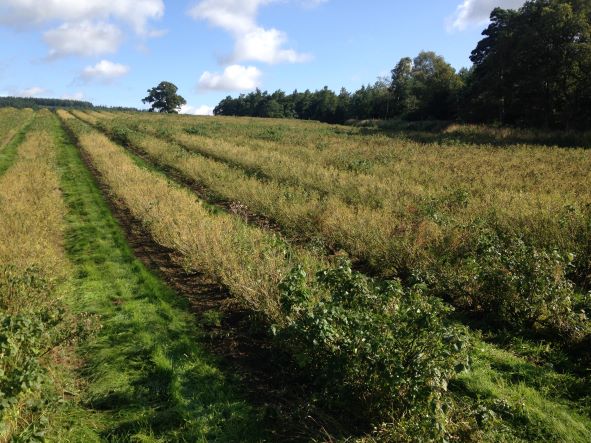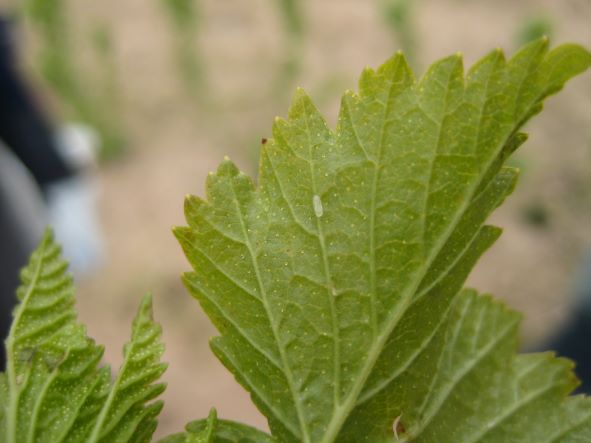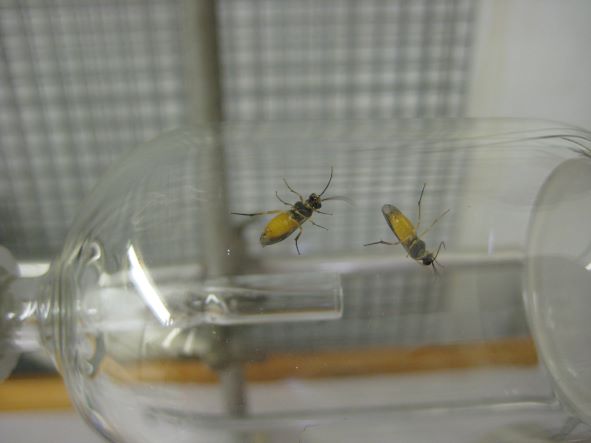Please click here to access the main AHDB website and other sectors.
- Home
- Knowledge library
- Blackcurrant sawfly
Blackcurrant sawfly
Take a look at this damaging pest and potential ways to tackle it.
Return to the main page: Developing novel biocontrol methods for pests and disease in blackcurrant
Why is this pest an issue?
The blackcurrant sawfly can be a damaging pest of the crop, leading to leaf damage and in worst cases, defoliation of the bush.
Severe defoliation of blackcurrant caused by blackcurrant sawfly
The damage caused can vary dramatically from year to year, making the application of insecticides difficult to time effectively.
Adults emerge from the soil in late April and May, laying eggs on the undersides of blackcurrant leaves. Eggs are oval, 1 mm long, pale green/white in colour, characteristically laid along vanes on the undersides of leaves.
Blackcurrant sawfly egg laid on underside of leaf
The resulting hatched larvae are 20 mm long with green head and body. The head is speckled black and the first and last two segments are partly yellow. The body is arched in a characteristic question mark shape when feeding on the edge of the leaf lamella.
Blackcurrant sawfly larva and frass on underside of leaf
The larvae feed in May and June, passing through four (males) or five (females) instars. The active pre-pupal stage deserts the bush and spins a cocoon in the soil, where it pupates. The next generation of adults emerge from late June onwards and the second brood of larvae feed in July and August. Occasionally, there may be a third generation.
What research has been done?
Sawfly research has centred on three key areas:
- Demonstrating sex pheromone attraction and investigating mating behaviour.
- Identifying the sawfly sex pheromone.
- Demonstrating pheromone activity, developing a lure and trapping system and calibrating in the field.
These three objectives were combined in a series of experiments.
In the early years, it was confirmed that male blackcurrant sawfly were attracted to virgin female sawfly caged in red delta traps indicating the presence of a long range attractant produced by the female.
Three components of a female sex pheromone were identified and then synthesised in the laboratory.
Collecting pheromone from adult female sawflies to aid the chemical identification of the compounds produced
Lures containing these synthesised compounds were tested in the field and were shown to attract large numbers of male blackcurrant sawfly.
Optimum blend
In the final year of the project, the optimum blend of chemical components of the synthesised pheromone was identified and found to further increase catches of male sawfly.
It was also found that this optimum blend was most effective if released from a polythene vial housed in a red delta trap.
These findings can now be used to develop a blackcurrant sawfly monitoring trap that can be made commercially available to growers.
This will reduce the use of prophylactic sprays and allow growers to time the application of control sprays more accurately, resulting in better control of the pest, reduced crop damage and reduced spray applications.
Useful links
AHDB funded research into blackcurrant botrytis control
Evaluation of fungicides for the control of Botrytis
Developing traps and thresholds for blackcurrant sawfly
Read the biocontrol in soft fruit guide
Download the bush fruit crop walkers' guide
Authors
These pages were originally authored by Michelle Fountain, Angela Berrie and Scott Raffle (NIAB) in 2015.





